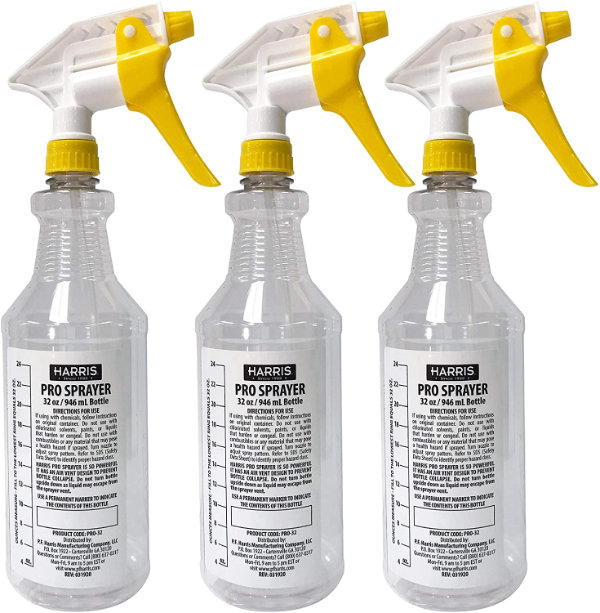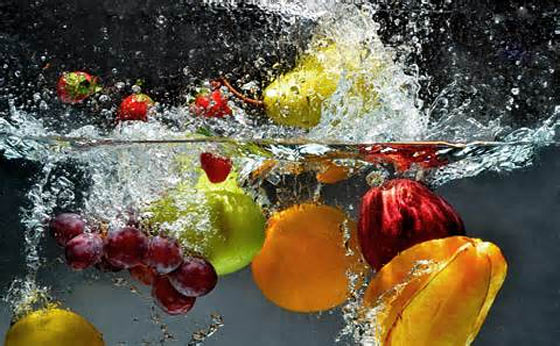Sanitizing Fruits and Vegetables in a Chlorine Bleach Wash or Spray Bottle
Set your mind at ease. I will provide the recipe how to disinfect your fruits and vegetables. Actually, two methods. A ‘wash’ (soak), and spray bottle. Each using regular chlorine bleach in a dilution recommended by the USDA and other sources.
There are plenty of sensible reasons why you should wash-sanitize-disinfect produce. Not the least of which is prior handling by others. Especially given the current ‘Covid’ environment. Sanitizing is simply a smart thing to do. Why? Because of the various ways these vegetables could get contaminated along the supply chain. Until, and including, when it’s on your grocery store shelves.
When buying fruits and vegetables at the grocery store, you probably don’t know exactly where it came from. And the sanitary (or lack thereof) conditions. All of the handling and processing. Whether or not (or how) it was cleaned. The number of people who picked up the produce and put it back down on the grocery store shelf. And the hygiene of those who handled it.
We occasionally hear of salmonella contamination of raw fruits and vegetables causing gastrointestinal illnesses. It’s not that hard to imagine how it could happen…
Here’s how to assure that your raw fruits and vegetables are sanitized:
How to Disinfect Fruits and Vegetables
Chlorine bleach. Yes, that’s right… Regular household bleach, diluted to the proper concentration. It will disinfect your produce.
Chlorine bleach solutions may be used for sanitizing raw fruits and vegetables.
Federal regulations permit the use of sodium hypochlorite (chlorine bleach) in washing produce (21 CFR Part 173).
The conditions:
- The concentration of sanitizer in the wash water must not exceed 2000 ppm hypochlorite.
- The produce must be rinsed with potable water following the chlorine treatment.
Having said that, most sanitizing operations will not need a sanitizer concentration greater than 200 ppm total chlorine to achieve the desired sanitizing effect. Unless the produce is very dirty. And provided contact times of one minute or greater (typically sufficient to achieve a thorough disinfect).
Chlorine Wash For Vegetables – Soak Method
This will result in a 200 ppm (parts per million) chlorine solution. Make the solution in a bowl for soaking the vegetables (for about one minute).
Bleach Solution For Soaking Bowl Method
Dilution of bleach to water ratio is 1:392 for bleach with 8.25% sodium hypochlorite as the active ingredient.
- 2 teaspoons Regular Bleach
- 1 Gallon of clean water
Let fruit or vegetables stand in solution for at least one minute.
Then rinse with tap water or potable water.
Note: Use Regular bleach (no additives) with sodium hypochlorite as the active ingredient. Today’s Regular Clorox bleach is ‘concentrated’ at 8.25% sodium hypochlorite. If you are using Regular bleach of 5 – 6.25% sodium hypochlorite (read the label), then use 3 teaspoons bleach per gallon to achieve a 200 ppm sanitizing solution.
Chlorine Wash For Vegetables – Spray Bottle Method
This will be the same formula above (200 ppm). Except I’ve adjusted the amounts to use typical size spray bottles.
You might use this method to spray the outer surface of vegetables instead of soaking them in a bowl. Like Avocados (for example). Or Cantaloupe. You get the idea…
As long as the surface is completely spray soaked, let it sit for a minute and then rinse off.
Bleach Solution For Spray Bottles:
This will make 200 ppm solution while using Regular Bleach with 8.25% sodium hypochlorite as active ingredient. Dilution of bleach to water ratio is 1:392
- 1/4 teaspoon with 16 ounces (2 cups) water
- 1/2 teaspoon with 32 ounces (quart) water
Use a heavy duty spray bottle that’s designed for chemicals. The nozzle will last longer…
HARRIS PRO 32 Ounce Spray Bottles
(view on amzn)

CAUTION: Do not mix Bleach with other household chemicals. Toxic fumes could result.
This is the vegetable brush that we also use. Very convenient.
OXO Vegetable Brush
(view on amzn)

Sources:
- Oklahoma Cooperative Extension Service
- Division of Agricultural Sciences and Natural Resources
- U.S. Food and Drug Administration
[ Read: Bleach Water Ratio For Disinfecting Surfaces | Make Your Own Disinfectant ]


Hey ya Ken.
Have you ever done the soak in water and Baking Soda method?
My relatives have been doing that for a long time.
They usually just fill the sink, dump in the Vegetables/whatever fill with water and dump in a few shakes of Baking Soda. Not very scientific I assure you.
Just curious if you have experiences or knowledge on this method.
Thoughts????
Arm & Hammer tips on their website
1tsp per 2 cups cold water
Or 3-4 Tbs per 2/3 sink full of water
Swish/soak 12-15 minutes
I’ve done that also use splash of vinegar in water to soak grapes/berries before rinsing (you’d be amazed at how much residue comes off the grapes)
NRP (& Blue)…
Your comment got me to thinking. (Difficult thing to do normally) As in, how does sodium bicarbonate sanitizing anything? I had absolutely no idea.
So, I went to NIH, NHS (UK), CDC, and several other medically oriented places. Including things mentioned here and probably 38 dozen more.
Sanitizing is the keyword. As in “Killing all them varmits residing on the stuff you/me/all o’ us have a need/desire to pack into our tummies”.
Well, turns out that vinegar and most things listed on a LOT of sites are well intentioned and are very good at CLEANING vegetables, etc. Not a lot of talk about sanitizing.
So, your relatives were most likely cleaning them garden oriented things fairly well, but they won’t meeting the present day definition for sanitizing.
Of course those that were struggling a generation or so ago didn’t have to worry about Covid 19, etc. So they did well in surviving.
In todays situations…..me thinks chlorine is the better answer. At least a spray bottle of the stuff, a good rinsing, then cook them babies up with some sauces, meat, chicken, trout…….whatever is handy.
Not to miss the wrap-around porch, cool breeze, magnificent sunset, and one each handy-dandy large size adult beverage.
DH washes all food products from stores with vinegar and/or baking soda. Meats with apple cider vinegar….veggies with baking soda. Always a good idea.
I just wash them with dish soap, like my dishes. And I make it a point to buy things I know the origin of.
I don’t know why I’m still thinking about this, could be the OCD kicking in, but I’d like to try and make my own sanitizing soap now. I’m also wondering how well peroxide would do on its own
You can buy peroxide soap. There is a manufacturer, Stiefel, that makes a very expensive bar of 10% peroxide under the brand name of Panoxyl. CVS (US drug store chain) makes a similar product that, although pricey, is much cheaper than Panoxyl. Both are marketed for treatment of acne. I’m a retired pharmacist who often worked in hospital IV prep rooms prior to retiring. I became something of a germaphobe due to my profession. I began using a dilute bleach solution years ago to clean veggies and eggs.
My one addition to the article above is to note that various brands of bleach found in grocers and hardware stores will vary from 1.5% to ~8% sodium hypochorite. So adjust accordingly. It’s not rocket science so I just eyeball my solutions. If using a 1.5% solution (which is between 5 to 6 times weaker than 8.5%) simply add about 2 ounces (60ml) of 1.5% to each gallon of water. I’ve always let it soak for about 15 minutes (based on a similar article I read years ago) and then rinsed the product well. If using a “half strength” bleach of 4% use about one ounce (30ml) bleach per gallon of water. Just be sure to rinse well and you don’t have to worry about using a slightly higher concentration.
While living in a third world country I always bleached both produce and eggs. Being a foreigner, I didn’t have the immunity a native would have had. It is important to be sure you don’t cross contaminate your food. Don’t put sanitized veggies on the counter where contaminated veggies sat. Also, the surfaces of certain things are too wrinkled to have effective sanitizing. Like cabbage and strawberries. My goal was to avoid parasites since night soil was commonly used as fertilizer. It worked. I lived there several years and never got parasites.
For a superior sanitizer, add equal parts vinegar (2 or 3 tsp) to the water make hypochlorous acid. It will bring the pH down to slightly acid, rather than strongly basic. This is totally safe (I use it every day in my bathroom and kitchen) and 100x more effective than bleach alone! It is basically swimming pool water.
Also, keep in mind that most bleach is not safe for food or drinking water (because it has thickeners, brighteners, fragrances, and dyes). NSF 60 certified bleach is the safest (drinking water purification standard)… Pure Bright by KIK is NSF 60, however Clorox Germicidal is not!
Does the bleach get ‘used up’? How many pounds of pre-rinsed veggies and eggs get soaked before the bleach concentration is no longer sanitizing in 1 minute?